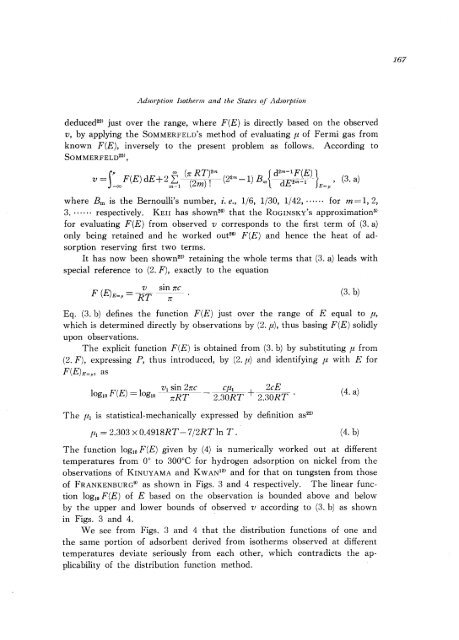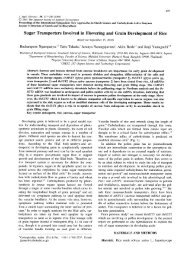ADSORPTION ISOTHERM AND THE STATES OF ADSORPTION
ADSORPTION ISOTHERM AND THE STATES OF ADSORPTION
ADSORPTION ISOTHERM AND THE STATES OF ADSORPTION
You also want an ePaper? Increase the reach of your titles
YUMPU automatically turns print PDFs into web optimized ePapers that Google loves.
Adsorption Isotherm and the States of Adsorption<br />
deduced 22 ) just over the range, where F(E) is directly based on the observed<br />
v, by applying the SOMMERFELD'S method of evaluating Ii of Fermi gas from<br />
known F(E), inversely to the present problem as follows. According to<br />
SOMMERFELD 25 ) ,<br />
Cp 00 (n- RT)2'" { d 2 "'-l F(E) }<br />
v=J_oo F (E)dE+22';:j- (2m-)!-(2 2m -1)B", -dpm--l - E=p' (3. a)<br />
where Bm is the Bernoulli's number, i. e., 1/6, 1/30, 1/42,······ for m = 1,2,<br />
3 ....... respectively. KEII has shown 26 ) that the ROGINSKY'S approximation 5 )<br />
for evaluating F(E) from observed v corresponds to the first term of (3. a)<br />
only being retained and he worked out 26 ) F(E) and hence the heat of adsorption<br />
reserving first two terms.<br />
It has now been shown 22 ) retaining the whole terms that (3. a) leads with<br />
special reference to (2. F), exactly to the equation<br />
v sm n-c<br />
F (E)E=p = RT----n-- .<br />
(3. b)<br />
Eq. (3. b) defines the function F(E) just over the range of E equal to Ii,<br />
which is determined directly by observations by (2. Ii), thus basing F(E) solidly<br />
upon observations.<br />
The explicit function F(E) is obtained from (3. b) by substituting Ii from<br />
(2. F), expressing P, thus introduced, by (2. Ii) and identifying Ii with E for<br />
F(E)E=p, as<br />
V l sin 2n-c Clil 2cE<br />
logjo F(E) = loglo -- n-RT- - 2.301

















